Category: Hunting Blog
Will Deer Hunting Opportunities be Reduced in Your Neighborhood?
There are currently debates among scientists about the impact coyotes can have on deer populations. Deer managers have picked up on this debate and are seeking information about the potential impacts of coyotes on deer. Fortunately there are multiple recent, high quality research projects that address this question. These studies show that coyotes can significantly reduce fawn survival. One research project in Alabama showed an increase in fawn survival of more than 140% after intensive trapping of coyotes on a 2,000 acre private property. Another research project based in South Carolina placed transmitters in the birth canal of dozens of does to be expelled upon fawns birthing. They found that more than half of the fawns were consumed by coyotes within hours of their birth.
As fawn recruitment and deer densities decrease over portions of their range, it is forcing state agencies to reconsider their harvest limits. Many biologists think that coyotes can’t be controlled, so the only solution is limiting hunter harvest of deer. Every hunter in the field is a deer manager. Hunters can discriminate for age and sex classes before harvesting a deer. Coyotes do not discriminate and will take down a mature buck, doe or fawn in order to fill their stomachs.
The approach of reducing hunter opportunity by lowering the doe/buck harvest will have ramifications for years to come. Hunter retention and hunter numbers have been on a downward trend for several years. Hunters and the fees they pay impact a huge number of conservation programs in each state. Hunter dollars drive many local economies that would not survive if it weren’t for the business of hunters during deer season. Reducing hunter opportunities could easily have an economic impact felt by the non-hunting community.
Reducing coyote populations requires effort (manpower) and resources (dollars). I know that most state agencies don’t have the budget to remove coyotes on a statewide basis. Private landowners can, however, bring resources to bear against coyotes. Hunters, landowners and state agencies need to work together to control coyote predation.
Private landowners were crucial to the restocking efforts that restored the current deer herds throughout the whitetail’s range. They protected deer, created habitat for deer, and allowed deer to be trapped and moved so others could enjoy this wonderful natural resource. I’m confident many landowners will want to protect their current deer herds from being significantly decreased in numbers, despite the fact that they’ve been told coyote populations can’t be controlled.
We all make choices every day. We favor flowers and our food plants by removing weeds either actively or by purchasing these products. We eat beef from pastures where weeds are controlled to ensure there’s enough grass. The US government successfully removes coyotes to protect farmers’ livestock. Why then can’t enough coyotes be removed to protect deer herds?
I agree that it is almost impossible to eliminate coyotes from a property. However, I’m 100% confident, based on experience, that coyote populations can be significantly reduced. I’m also very confident that many landowners, co-ops, lease holders, and other wildlife managers, will spend their resources reducing coyotes. They simply need the permission along with appropriate seasons and tools to pursue coyotes at the correct time of year. Coyotes removed just before or during fawning/nesting season will save more fawns and turkey poults than coyotes removed during the traditional winter trapping season.
Some states currently allow these tools and others don’t. In either case, I encourage hunters to work with state agencies to ensure whitetail populations don’t follow the trend of elk populations. Wolves have significantly reduced elk populations, the opportunities for families to interact with elk and the revenue generated by elk viewing and hunting.
I encourage state wildlife management agencies to allow deer managers to use all ethical tools to remove coyotes. The resources required to remove coyotes will certainly be self-limiting in most cases. Choosing not to manage coyotes where they are a problem is simply saying you refuse to manage deer and other game species.
I don’t dislike coyotes – in the right balance. To achieve that balance the coyote population must be reduced in many areas of the United States. However, many folks are not able to manage coyotes on their properties under the current regulations to sustain current deer harvest objectives. New guidelines need to be initiated in order to preserve the deer herds that my predecessors worked hard to restore.
This is a simple subject. I hope it is not complicated by politics before it’s too late. I really dislike hearing that the only option to coyote management is to reduce hunter opportunities because coyotes can’t be controlled and are destroying deer populations. If coyotes aren’t controlled, deer densities will decrease and so will the number of hunters and the dollars they generate to conserve and protect all species of wildlife and wild places.
Growing Deer together,
Grant
Trapping Raccoons to Protect Turkey Nests
I really enjoy wild turkeys. I enjoy seeing and hearing them. I enjoy calling to them. I enjoy eating them! I like seeing a raccoon, but I get more excited when I see a wild turkey.
Several years ago raccoon pelts sold for $40-$50 each!! Folks hunted and trapped raccoons as it was possible to make a few hundred dollars or more a week! That was a great addition to the average income in those days so many, many folks pursued raccoons! To my knowledge, raccoons were never over harvested, but their numbers were certainly lower than they are now. There’s not much of an incentive to hunt or trap raccoons for their fur as the current prices are generally $10 or less per pelt. Given the current prices of fuel, traps, etc., folks are not financially motivated to harvest raccoons.
There are a few locations where disease has reduced the raccoon population, but in general their populations are high and uncontrolled throughout their range. Raccoons are very effective turkey predators. They will kill adult turkeys, but typically take their largest toll on turkey populations by consuming the eggs. Raccoons have a very good sense of smell. Hen turkeys return to their nest site to lay an egg daily for approximately 10 days (more or less), and then remain on the nest to incubate the eggs for another 28 days.
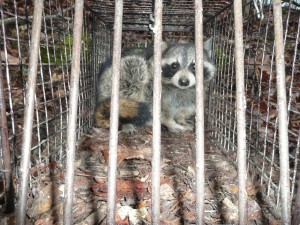 Hens smell very strong if they get wet. Even I can smell them! If it rains and the hen gets wet, it’s very easy for predators such as raccoons to smell the hen or where the hen has walked and trail her to her nest. Once the nest is found by a raccoon, the hen is unable to defend it against a raccoon and all eggs are destroyed. Sometimes the hen is killed while attempting to defend her nest and other times she flees.
Hens smell very strong if they get wet. Even I can smell them! If it rains and the hen gets wet, it’s very easy for predators such as raccoons to smell the hen or where the hen has walked and trail her to her nest. Once the nest is found by a raccoon, the hen is unable to defend it against a raccoon and all eggs are destroyed. Sometimes the hen is killed while attempting to defend her nest and other times she flees.
I enjoy trapping and my family really likes pelts!! So it’s a double benefit to engage my family in trapping predators while limiting turkey nest predation by controlling the raccoon population. Trapping can be a great way for the family to enjoy the outdoors together. A few traps can be purchased and used as a learning experience or a more serious approach can be taken in an effort to manage raccoons.
Either way, it’s important for us to be responsible stewards of our natural resources. This means making choices and I choose to favor turkeys rather than raccoons. What’s your choice?
Growing Deer together,
Grant
Critical Pieces of Camouflage
Late December Strategy
Female fawns generally reach puberty when they attain a body weight of approximately 70 pounds. In areas where the rut occurs during November and there is ample quality forage, female fawns generally reach puberty during December of their first year. That’s valuable information for folks that like to hunt mature bucks!
By December, deer throughout most of the whitetails range have had enough encounters with hunters to be in a state of constant high alert. Hence, mature bucks rarely visit areas where they are likely to encounter hunters during daylight hours. This means mature bucks typically avoid food plots, ag fields, and other locations hunters frequent during daylight hours.
There is one common exception. Mature bucks will follow receptive female fawns during daylight hours into areas that are frequently hunted. Knowing this, I commonly use this strategy during mid to late December in areas where the rut occurs during November and there is ample quality forage available to support rapid fawn development.
I like hunting large openings such as food plots, ag fields, etc., as they can usually be approached from downwind, using Minimal Disturbance Entry (M.D.E.) tactics. In fact, I used this strategy last Saturday. I was hunting a property near Dorena, Missouri which is an area with lots of agricultural crops and limited cover. The property where I was hunting was the exception in that area as it has gads of cover surrounding a large agricultural field.
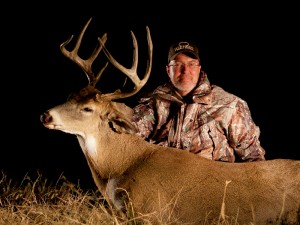 I expected several does and fawns to enter a staging area for that field before dark. I didn’t expect many mature bucks to enter the field unless drawn there by a female fawn that was receptive. During a day with a northwest wind I entered the field from the east and hung a Muddy ladder and hang-on stand during lunch for my cameraman, Adam, and myself. I selected a site that would allow me to watch an area of the field where the sign indicated several deer with smaller tracks had been entering. About 30 minutes before dark several doe/fawn groups began entering the field. After another 20 minutes went by, a buck I estimated to be 4.5 years old followed a female fawn into the field. After the cameraman assured me he was filming and had a clear view, I took some time to enjoy the moment and then let the muzzleloader’s hammer fall.
I expected several does and fawns to enter a staging area for that field before dark. I didn’t expect many mature bucks to enter the field unless drawn there by a female fawn that was receptive. During a day with a northwest wind I entered the field from the east and hung a Muddy ladder and hang-on stand during lunch for my cameraman, Adam, and myself. I selected a site that would allow me to watch an area of the field where the sign indicated several deer with smaller tracks had been entering. About 30 minutes before dark several doe/fawn groups began entering the field. After another 20 minutes went by, a buck I estimated to be 4.5 years old followed a female fawn into the field. After the cameraman assured me he was filming and had a clear view, I took some time to enjoy the moment and then let the muzzleloader’s hammer fall.
If the herd/habitat conditions I’ve described match those where you hunt, consider patterning fawns as a strategy to harvest a mature buck during the late season. The more fawns you pattern during the late season, the more likely one of them will be receptive and be followed by a mature buck. This may not be a onetime hunt like keying in on a bedding area, etc. However, each day there’s a chance another female fawn will become the ultimate attractant. It’s critical to not alert the deer to your presence as then the does and fawns will begin avoiding the area. Always approach stands with M.D.E. tactics and enjoy watching the fawns. One of them may be followed by a mature buck.
Growing Deer together,
Grant
Late season hunting
I enjoy late season hunting. I like hunting when the temperatures are cold. I like hunting when the leaves are off. But most of all, I like being able to easily identify limited resources that deer need. As the temperatures drop, deer require more food to maintain their body temperatures so they need to eat. In most areas of the whitetails’ range quality food is limited in distribution during the late season. Most acorns have been consumed. The crops in agricultural fields usually have been harvested. The food in smaller, unprotected food plots has usually been consumed.
Because of the limited food sources, hunters can identify where deer are feeding. However, that doesn’t mean seeing mature bucks will be easy! Mature bucks are masters at surviving – that’s why they reached maturity. So, it usually requires more skill than simply locating food sources to harvest mature bucks during the late season. Mature bucks often react to the smallest amount of pressure and avoid locations during daylight where they’ve encountered hunters recently. Since it is late season, most food plots have been hunted many times and are areas mature bucks avoid during daylight hours.
I take a different approach. I use the time lapse feature of Reconyx trail cameras to scout preferred food sources during the late season. This allows me to gain M.R.I. (Most Recent Information) about the age of bucks using a food source, predictability of bucks using that food source, when they are using the food source, and how they approach/leave the food source. Using this information, I can, if necessary, hang stands during periods when deer are least likely to be at or near the food source.
Late season mature bucks have usually been heavily pressured. They are very alert and conditioned to avoid all forms of predation. However, by using tactics to avoid letting them know you are in the area, the late season can be the best time to pattern a mature buck because of his dependence on food! I really enjoy hunting the late season!
Growing Deer together,
Grant
December 11, 2009, December 10, 2010, December ??, 2011
I eagerly awaited the hunt this morning. I was more excited and curious than most mornings. This was because last year on December 11 there were more Reconyx images taken of mature bucks during the daytime than any other day last year. Was that simply coincidence? Probably, but I was excited enough to get up earlier than normal this morning. I rarely hunt stands that overlook food plots during the morning, but we had eight images of Giant 10 during mid morning in the Big Boom plot at The Proving Grounds two days ago. So Brad and I did our normal routine of putting on our hunting clothes in the woods before light and attempted to hike quietly through the woods to a never hunted before stand hung on the north side of Big Boom. The wind was from the south this morning and all seemed well. At about 7:30 Brad spotted three bobcats hunting a log pile leftover from clearing the Big Boom Plot.
I squeaked and the largest cat started coming from 100 yards out. However, the cat turned and continued hunting with the other two cats. At 8:15 three fawns entered Big Boom to our left. The wind was in our favor so we simply enjoyed the view. Then six does and fawns entered the field to our left.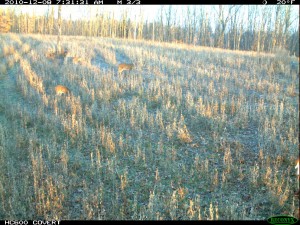
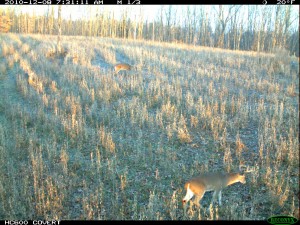
At this point, I strongly suspected a buck would be along shortly to see if any of the does or fawns were ready to dance. Then I spotted 5 more does and fawns to our right. Finally a two or three year old buck entered to our far left and began grunting and pestering a fawn. He wasn’t a deer on my hit list, but I enjoyed watching him.
Brad and I observed 15 deer simultaneously at The Proving Grounds this morning! That’s the most I’ve ever seen here at one time, or in a day, or in most weeks! No shots were fired, but it was a very enjoyable hunt. I can’t wait to check the trail cameras and see if there was similar action at other locations throughout The Proving Grounds. I’ve already marked my calendar for this day next year. I wonder if today and last year were simply coincidence…
Growing Deer together,
Grant
Protecting the future of hunting – one coyote at a time
Last Saturday morning was very cold and windy at The Proving Grounds. It had been unseasonably cold for days so I assumed the deer would be feeding late into the morning. I had selected a stand about 100 yards from a bedding area in hopes of observing deer returning to cover. I was able to approach the stand with the strong wind in my face and the set-up seemed ideal. The wind was shaking the tree, even though my stand was located in a bottom. I rarely hunt the bottoms at The Proving Grounds unless the wind is howling as other conditions tend to allow the wind to swirl. Swirling wind was a non issue last Saturday. Keeping my balance while riding (versus standing in) the stand was an issue.
During the late morning I spotted a coyote moving about 50 yards away. Recent research is clear that coyotes consume lots of fawns. Many times folks state that only a few coyotes actually kill deer. However, research from South Carolina clearly showed that a vast majority of fawns that were killed by coyotes were killed by different individuals (the wonders of genetics in research). Therefore, I consider each coyote a potential fawn and turkey killer. Coyotes also harass and kill adult deer. I wonder how many hunts I’ve had where deer I had patterned changed their travel to avoid coyotes.
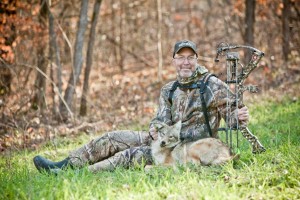 For those and other considerations, I instantly began squeaking (sucking air through tight lips) when I saw the coyote. The cameraman began filming and I readied the Z7. It was only seconds between when I first saw the coyote and when my arrow hit the mark. The first step of making a nice coyote pelt had been completed. I never worry about spooking deer during a hunt when shooting a coyote. Rather I consider the fawns, poults, and adult deer I’m a bit more likely to encounter during the future because I opted to take the shot. What will you do the next time you see a coyote while deer hunting?
For those and other considerations, I instantly began squeaking (sucking air through tight lips) when I saw the coyote. The cameraman began filming and I readied the Z7. It was only seconds between when I first saw the coyote and when my arrow hit the mark. The first step of making a nice coyote pelt had been completed. I never worry about spooking deer during a hunt when shooting a coyote. Rather I consider the fawns, poults, and adult deer I’m a bit more likely to encounter during the future because I opted to take the shot. What will you do the next time you see a coyote while deer hunting?
Growing Deer together,
Grant
Hunting Late Season Hit List Bucks
Brad and I are preparing to hunt/film this afternoon. The wind is out of the south and the temperature is seasonal to a bit cold (as it has been for a few days). Yesterday Brad checked all of our Reconyx trail cameras and reviewed the images (8,000+). Does and fawns at The Proving Grounds are beginning to frequent food plots regularly. However, images of mature bucks indicated they are still looking for a date. There were no images of mature bucks (4.5 years old or older) that indicated they were on a food/cover pattern. Given this our strategy for the next few days is to hunt where we can see the maximum number of does/fawns and hope that one of them has a hit list buck trailing behind.
We did have one two or three year old buck that was showing a pattern. He was repeatedly using a gap we created in one of our fences. We have a ground blind 10 yards away, but that buck is not on our hit list. I hope he maintains that pattern until muzzleloader or youth season so my father or one of my daughters can enjoy hunting the “fence gap.”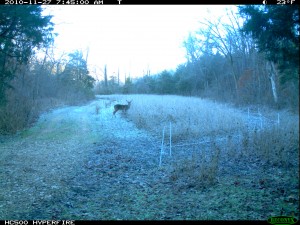
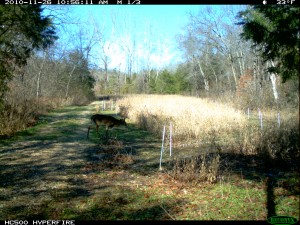
We’ve purposely have not hunted food plots much at The Proving Ground this season. Deer were simply choosing acorns. That is great if you are hunting in areas where oaks are rare like ag areas. However, when oaks dominate the landscape and the preferred food is everywhere, a huge acorn crop is a detriment to hunters. Thankfully the acorns are about all consumed and the food plots at The Proving Grounds haven’t been hunted much so the deer should be comfortable feeding there during daylight hours. We’ll start confirming if this is a good strategy this afternoon. We’ll approach and leave the stands carefully as all the work of growing the crops, hanging stands, scouting, etc., can be spoiled by carelessly alerting mature deer to our presence. Hunting mature bucks successfully usually requires a much different strategy than those I used when I was younger and simply looking to harvest any buck.
Growing Deer (and learning) together,
Grant
Help Deer by Voting for Joe!
When I first entered grad school trail camera surveys for deer wasn’t even a concept. Heck, trail cameras weren’t commercially available. I wished to estimate the number of deer where I was doing research and no one locally offered a good solution.
I had heard of a biologist in South Carolina that was doing great deer work named Joe Hamilton. I wrote Joe a letter and asked his opinion about how to best estimate the number of deer at my research site. He responded rapidly with a lengthy, hand-written letter that explained how to conduct a spotlight survey for deer, and included data forms, etc. Joe had no reason to respond except to help a fledging grad student.
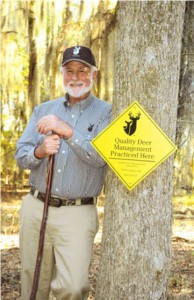 That’s Joe – ready to help anyone understand deer and deer hunting better. I’m not a sentimental guy. I rarely keep anything – especially letters. However, I was so struck that Joe spent that much time responding to me, that I keep his letter. I have it still today – more than 20 years later. Since then, Joe became one of my mentors and my friends. I’ve shared a number of fires with Joe and have learned more from him than I did in most of my college classes. Joe has always given his time and knowledge freely.
That’s Joe – ready to help anyone understand deer and deer hunting better. I’m not a sentimental guy. I rarely keep anything – especially letters. However, I was so struck that Joe spent that much time responding to me, that I keep his letter. I have it still today – more than 20 years later. Since then, Joe became one of my mentors and my friends. I’ve shared a number of fires with Joe and have learned more from him than I did in most of my college classes. Joe has always given his time and knowledge freely.
I now have the opportunity, in a very small way, to attempt to repay Joe some of the many blessings he has given me. Joe has been nominated for the prestigious Budweiser Conservationist of the Year Award. The recipient of this award will receive $50,000 to use to further their work in conservation. I believe Joe truly deserves that award. As the founder of the Quality Deer Management Association, Joe can use those funds to continue benefiting the white-tailed deer and those of us that enjoy learning about and hunting deer.
I’m asking you to join me in voting for Joe Hamilton. The process is easy. I’ve already voted. Please vote today for Joe. Thanks in advance for your consideration! Joe thanks for helping me 20+ years ago and for continuing to help me today. I truly value our friendship!
Join me and vote for Joe as Budweiser’s Conservationist of the Year. Simply provide the required information (you must be 21 to vote), click the bubble under Joe Hamilton’s photo, and then click Vote Now.
Growing Deer together,
Grant
Boone and Crocket Experience
It getting cold and the rut is in full swing in most of the whitetails’ range. There have probably been thousands of articles written about hunting the rut. However, as deer herds have changed so should the hunting techniques. There are probably more mature bucks throughout the whitetails’ range now than ever. Mature bucks behave and influence the behavior of other deer differently than yearling bucks – what most of us grew up hunting. Deer herd population dynamics have changed, and so has the recruitment of new hunters. That’s one reason why I’m so proud of Liam Story and his father Jared.
Liam and Jared joined my family for the opening day of rifle season at The Proving Grounds. Liam is an avid football player and fan. Saturday is football day for many young men. However, Liam opted to join his Dad for some time in a ground blind. Liam remained patient and was rewarded with the opportunity to harvest his first deer!! Liam made a great shot with a youth model .243 loaded with a Barnes bullet and the 112 pound buck never took another step.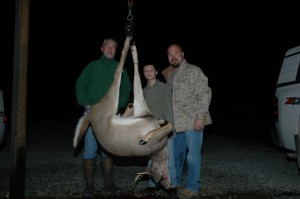
It was a Boone and Crocket experience for all involved! Liam’s mom joined us for pictures. I helped debone the deer and was blessed to hear Liam share the details of his hunt.
Why am I so excited about Liam’s hunt? Because it is becoming rare that youth are opting to go hunting rather than participate in any of the gads of other forms of activities. I’m a huge believer that many extremely valuable lessons can be learned while hunting. Liam and his father clearly shared an event that neither of them will ever forget. Liam’s success was a great motivation for him to want to hunt again. The meals their family will share from Liam’s buck will be another reinforcement to the quality experience that can’t be duplicated by most other activities.
Deer herds throughout much of the whitetails range are changing for the better. Unfortunately, the number of hunters joining our ranks has been decreasing for years. Good deer herds are managed by good hunters. If you haven’t been blessed by helping a new hunter, then get off the couch.
Growing Deer (and new hunters) together,
Grant



